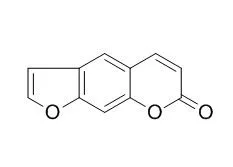| In vitro: |
| Phytomedicine. 2014 Jun 15;21(7):970-7. | | Psoralen reverses docetaxel-induced multidrug resistance in A549/D16 human lung cancer cells lines.[Pubmed: 24703328] | Chemotherapy is the recommended treatment for advanced-stage cancers. However, the emergence of multidrug resistance (MDR), the ability of cancer cells to become simultaneously resistant to different drugs, limits the efficacy of chemotherapy. Previous studies have shown that herbal medicine or natural food may be feasible for various cancers as potent chemopreventive drug. This study aims to explore the capablility of reversing the multidrug resistance of docetaxel (DOC)-resistant A549 cells (A549/D16) of Psoralen and the underlying mechanisms.
METHODS AND RESULTS:
In this study, results showed that the cell viability of A549/D16 subline is decreased when treated with Psoralen plus DOC, while Psoralen has no effect on the cell proliferation on A549 and A549/D16 cells. Furthermore, mRNA and proteins levels of ABCB1 were decreased in the presence of Psoralen, while decreased ABCB1 activity was also revealed by flow cytometry. Based on these results, we believe that Psoralen may be feasible for reversing the multidrug resistance by inhibiting ABCB1 gene and protein expression.
CONCLUSIONS:
Such inhibition will lead to a decrease in ABCB1 activity and anti-cancer drug efflux, which eventually result in drug resistance reversal and therefore, sensitizing drug-resistant cells to death in combination with chemotherapeutic drugs. | | Pak J Pharm Sci. 2015 Mar;28(2 Suppl):667-70. | | Effects of psoralen on chondrocyte degeneration in lumbar intervertebral disc of rats.[Pubmed: 25796142] | Discuss the internal mechanism of delaying degeneration of lumber intervertebral disc.
METHODS AND RESULTS:
The cartilage of lumbar intervertebral disc of SD rats was selected in vitro, then cultured by tissue explant method, and identified by HE staining, toluidine blue staining and immunofluorescence. The optimal concentration of Psoralen was screened by cell proliferation assay and RT-PCR method. The cells in third generation with good growth situation is selected and placed in 6-well plate at concentration of 1×10(5)/well and its expression was tested. Compared to concentration of 0, the mRNA expression of Col2al (Collagen Ⅱ) secreted by was up regulated chondrocyte of lumbar intervertebral disc at the concentration of 12.5 and 25μM (P<0.0 or P<0.01). The aggrecan mRNA of Psoralen group was higher than blank control group (P<0.01); compared with IL-1β induced group, the mRNA expression of Col2al was significantly increased but the mRNA expression of ADAMTS-5 was significantly decreased in Psoralen group (P<0.01).
CONCLUSIONS:
These findings suggest that, Psoralen can remit the degeneration of lumbar intervertebral disc induced by IL-1β to some extent, and affect the related factors of IL-1β signaling pathway. | | Int J Mol Med . 2018 Jun;41(6):3727-3735. | | A novel psoralen derivative-MPFC enhances melanogenesis via activation of p38 MAPK and PKA signaling pathways in B16 cells[Pubmed: 29512683] | | Abstract
As an active compound, Psoralen is present in various Chinese herbal medicines and has exhibited significant activity in skin disease treatment. Its derivative 8-methoxypsoralan (8-MOP) is the most commonly used drug to induce repigmentation of vitiligo. In our previous screening assays, 4-methyl-6-phenyl-2H-furo[3,2-g]chromen-2-one (MPFC), a Psoralen derivative, was identified as more effective tyrosinase and melanin activator than the positive control 8-MOP in consideration of low doses, as well as low toxicity. The overall purpose of this study was to characterize the melanogenic effect and mechanisms of MPFC in B16 cells. The melanin biosynthesis effects of MPFC were determined by examination of cellular melanin contents, tyrosinase activity assay, cyclic adenosinemonophosphate (cAMP) assay, and western blotting of MPFC-stimulated B16 mouse melanoma cells. Our results showed that MPFC enhanced both melanin synthesis and tyrosinase activity in a concentration-dependent manner as well as significantly activated the expression of melanogenic proteins such as tyrosinase, tyrosinase-related protein-1 and tyrosinase-related protein-2. Western blot analysis showed that MPFC increased the phosphorylation of p38 mitogen-activated protein kinase and cAMP response element-binding protein (CREB) as well as the expression of microphthalmia-associated transcription factor (MITF). Moreover, MPFC stimulated intracellular cAMP levels and induced tyrosinase activity and melanin synthesis were attenuated by H89, a protein kinase A inhibitor. These results indicated that MPFC-mediated activation of the p38 MAPK and the protein kinase A (PKA) pathway may shed light on a novel approach for an effective therapy for vitiligo. |
|






 Cell. 2018 Jan 11;172(1-2):249-261.e12. doi: 10.1016/j.cell.2017.12.019.IF=36.216(2019)
Cell. 2018 Jan 11;172(1-2):249-261.e12. doi: 10.1016/j.cell.2017.12.019.IF=36.216(2019) Cell Metab. 2020 Mar 3;31(3):534-548.e5. doi: 10.1016/j.cmet.2020.01.002.IF=22.415(2019)
Cell Metab. 2020 Mar 3;31(3):534-548.e5. doi: 10.1016/j.cmet.2020.01.002.IF=22.415(2019) Mol Cell. 2017 Nov 16;68(4):673-685.e6. doi: 10.1016/j.molcel.2017.10.022.IF=14.548(2019)
Mol Cell. 2017 Nov 16;68(4):673-685.e6. doi: 10.1016/j.molcel.2017.10.022.IF=14.548(2019)